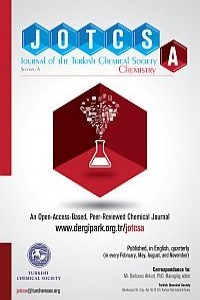The Investigation of the Effect of Mineral Oils which Have Different Specifications on The Performance of Palm- and Tallow-Based Soap Recipes
In this work, three different type of mineral oils, with same amount (%1 as ratio), have been added to two different soap recipes from animal origin oils and vegetable derived fatty acids that have the same rate of foaming agent and similar critical specification values.The pH / conductivity, foam performance, hardness and pellet tests were applied to the soaps obtained; and the results were analyzed by comparing the effects of different specifications of mineral oil. The result of this study, the effect of addition of mineral oils on the soap samples were clarified and characterized by advanced research analysis.
Keywords:
Soap, mineral oils pH, conductivity, foam performance,
___
- 1. TSE Sabun Türk Standardı , [cited 2018 Nov 3], Available from: https://intweb.tse.org.tr/standard/standard/Standard.aspx?081118051115108051104119110104055047105102120088111043113104073088066122074112099075071049107075 2. Spitz L. Soap Manufacturing technology. London, United Kingdom Academic Press and AOCS Press, Second edition; 2018.
- 3. Schumann K., Siekmann K. Soaps. Ullman's Encylopedia of Industrial Chemistry. 1993, A(249) : 247-266.
- 4. O'Connor S., Rudkowska I., Chapter Two - Dietary Fatty Acids and the Metabolic Syndrome: A Personalized Nutrition Approach. Advances in Food and Nutrition Research. 2019, 87, 43-146.
- 5. Menaa F., Bouzid Menaa B., Kahn B.A., Menaa A., Chapter 2 - Trans Fats and Risks of Cardiovascular Diseases: Facts or Artifacts. Handbook of Lipids in Human Function, 2016, 21-38.
- 6. Sabun ve Deterjan Endüstrileri, Bölüm II, 2019. Available from: http://webcache.googleusercontent.com/search?q=cache:sqBvxybA0NQJ:content.lms.sabis.sakarya.edu.tr/Uploads/65467/49523/b%25C3%25B6l%25C3%25BCm-%25C4%25B1%25C4%25B1_sabun_ve_deterjan_k%25C4%25B1sa.doc+&cd=1&hl=tr&ct=clnk&gl=tr
- 7. Hall N., Implications of Soap Structure for Formulation and User Properties. Soap Manufacturing Technology (Second Edition). 2016,1-33 p.
- 8. Hill M., Moaddel T., Soap Structure and Phase Behavior. Soap Manufacturing Technology. 2016, 35-54 p.
- 9. Alpar S.R., Organik Sınai Kimya, İstanbul Üniversitesi Kimya Fakültesi Yayınları, İstanbul, 1969.
- 10. Alpar S.R., Hakdiyen M.İ., Bigat T. Sınai Kimya Analiz Metodları, İstanbul Üniversitesi Kimya Fakültesi Yayınları, İstanbul, 1971.
- 11. Bektaşoğlu S.Y. İgeme Ürün Profili. İgeme, 1995, 4, 1-20 p.
- 12. DPT. Kimya Sanayinin Genel Değerlendirilmesi ve Yatırım Alanları Özel İhtisas Alt Komisyon Raporu, Devlet Planlama Teşkilatı, 1991. 13. Koç, N., Köpük ve Köpürme prensipleri, Available from: http://www.kmo.org.tr/resimler/ekler/de0e671163cd540_ek.pdf?dergi=68
- 14. Douguet M., Picard C., Savary G., Merlaud F., Loubat-Bouleuc F., Grisel M. Spreading properties of cosmetic emollients: Use of synthetic skinsurface to elucidate structural effect. Colloids and Surfaces B: Biointerfaces , 2017, 154, 307–314 p.
- 15. The Editors of Encyclopaedia Britannica, Mineral oil [Internet]. Encyclopædia Britannica Encyclopædia Britannica inc., 2019 [cited 2019 Nov 27]. Available from: https://www.britannica.com/technology/mineral-oil
- 16. Prof. Dr.Alexander Ya. Malkin, Prof. Dr.Avraam I Isayev, Applications of Rheology, Rheology Concepts, Methods, and Applications (Second Edition), 2012. Chapter 6, 365-420 p. Available from: https://doi.org/10.1016/B978-1-895198-49-2.50011-6
- 17. Mineral oil [Internet]. 2020 ChemicalSafetyFacts.org. [cited 2019 Nov 27]. Available from: https://www.chemicalsafetyfacts.org/mineral-oil/
- 18. Cosmetics – CosIng, Ingredient: PARAFFINUM LIQUIDUM [Internet], European Commission, Internal Market, Industry, Entrepreneurship and SMEs, Sectors, Cosmetics, CosIng, [cited 2019 Nov 27]. Available from: https://ec.europa.eu/growth/tools-databases/cosing/index.cfm?fuseaction=search.details_v2&id=35850 19. Taherian R., The Theory of Electrical Conductivity. Electrical Conductivity in Polymer-Based Composites. Experiments, Modelling, and Applications, Plastics Design Library. 2019, 1-18 p.
- Başlangıç: 2014
- Yayıncı: Türkiye Kimya Derneği
Sayıdaki Diğer Makaleler
Ahmet Ozan ÖZGEN, Ozan Emre EYÜPOĞLU
F. Zehra KÜÇÜKBAY, Zehra TEKİN
Shaza ALSHAAL, Manal DAGHESTANİ, Francois KARABET
Atolani ATOLANİ, Olorundare O.E, Banerjee PRİYANKA, Osin O, Preissner R, Njan A.A
Vladimir SULİMOV, İvan ILİN, Danil KUTOV, Alexey SULİMOV
Sinem TEMİZEL, Altuğ Mert SEVİM
Ezgi GÜLÇAY, İlknur ERUCAR FİNDİKCİ
Sabitu Babatunde OLASUPO, Adamu UZAIRU, Gideon Shallangwa, SANI UBA
